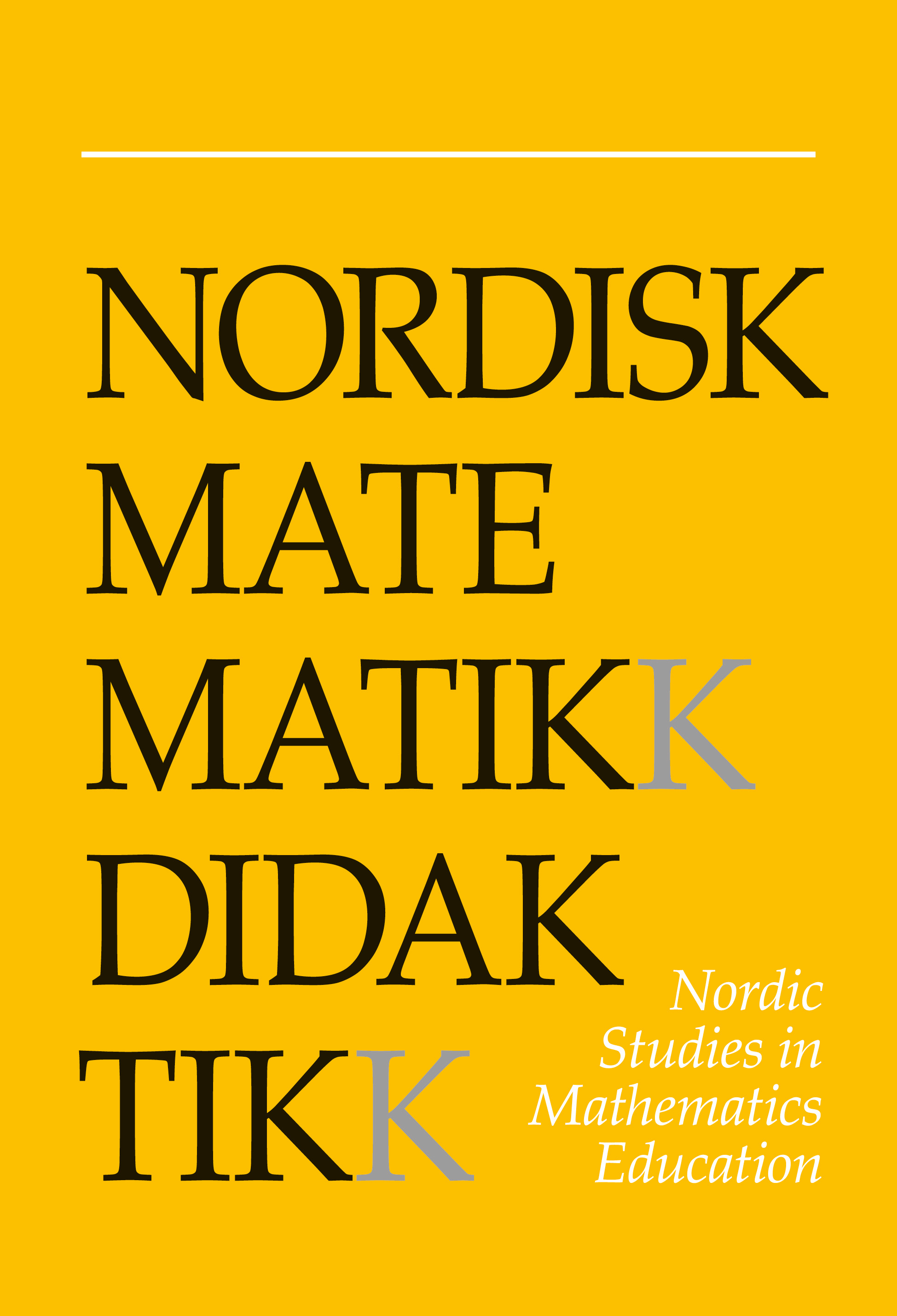A modelling approach to probability – analysing students’ conceptual structures
DOI:
https://doi.org/10.7146/nomad.v18i4.148520Abstract
This research study investigates how middle school students use probability to model random behaviour in real-world contexts and how they articulated fundamental probabilistic concepts to show aspects of the mental models that they generated. This article is concerned with the conceptual structures that the students develop when exploring computer-based simulations. The results suggest that the students relied on their experience to provide a context reality from which to construct their mental model of the situation, from which they then defined the probability model. While the students attempted to build mental models, they checked the adequacy of the mapping between their probability models and reality by interrogating the context of their personal experiences. The results also suggest that the way students express this relationship between signal and noise seems to have a particular importance in building comprehensive models that link observed data to modelling distributions.
References
Baguley, T. S. & Payne, S. J. (1999). Memory of spatial descriptions: a test of the episodic trace hypothesis. Memory and Cognition, 27, 962-973. https://doi.org/10.3758/BF03201227
Bartholomew, D. (1995). What is statistics? Journal of the Royal Statistical Society. Series A (Statistics in Society), 158 (1), 1-20. https://doi.org/10.2307/2983401
Batanero, C. Henry, M. & Parzysz, B. (2005). The nature of chance and probability. In G. A. Jones (Ed.), Exploring probability in school: challenges for teaching and learning (pp. 15-37). New York: Springer. https://doi.org/10.1007/0-387-24530-8_2
Borovcnik, M., Bentz, J. & Kapadia, R. (1991). A probability perspective. In R. Kapadia & M. Borovcnik (Eds.), Chance encounters: probability in education (pp. 27-71). Dordrecht: Kluwer. https://doi.org/10.1007/978-94-011-3532-0_2
Chance, B., Ben-Zvi, D., Garfield, J. & Medina, E. (2007), The role of technology in improving student learning of statistics. Technology Innovations in Statistics Education Journal, 1 (1). Retrieved from http://escholarship.org/uc/search?entity=uclastat_cts_tise;volume=1;issue=1 https://doi.org/10.5070/T511000026
Chaput, B., Girard, J.-C. & Henry, M. (2008), Modeling and simulations in statistics education. In C. Batanero, G. Burrill, C. Reading & A. Rossman (Eds.), Joint ICMI/IASE study: teaching statistics in school mathematics?Challenges for teaching and teacher education. Proceedings of the ICMI Study 18 and 2008 IASE round table conference, ICMI and IASE, Monterrey. Retrieved from http://iase-web.org/documents/papers/rt2008/T1P1_Chaput.pdf
Chaput, B., Girard, J.-C. & Henry, M. (2011). Frequentist approach: modelling and simulation in statistics and probability teaching. In C. Batanero, G. Burrill & C. Reading (Eds.), Teaching statistics in school mathematics? Challenges for teaching and teacher education, a joint ICMI/IASE study: the 18th ICMI study (pp. 85-95). New York: Springer. https://doi.org/10.1007/978-94-007-1131-0_12
Cobb, G. W. & Moore, D. (1997). Mathematics, statistics, and teaching. The American Mathematical Monthly, 104, 801-823. https://doi.org/10.1080/00029890.1997.11990723
De Moivre, A. (1967). The doctrine of chances: or a method of calculating the probabilities of events in play. New York: Chelsea Publishing Company. (Original work published in 1756)
Eichler, A. & Vogel, M. (2012). Basic modelling of uncertainty: young students' mental models. ZDM - The International Journal on Mathematics Education, 44 (7), 841-854. doi: 10.1007/s11858-012-0451-9 https://doi.org/10.1007/s11858-012-0451-9
Garfield, J. & Ben-Zvi, D. (2008). Developing students' statistical reasoning: Connecting research and teaching practice. Berlin: Springer.
Johnson-Laird, P. N. (1983). Mental models. Cambridge University press.
Kinstch, W. (1998). Comprehension: a paradigm for cognition. Cambridge University Press.
Konold, C. & Miller, C. D. (2011). TinkerPlots: dynamic data exploration (Version 2.0) [Computer software]. Emeryville: Key Curriculum.
Lightner, J. (1991). A brief look at the history of probability and statistics. Mathematics Teacher, 84 (8), 623-630. https://doi.org/10.5951/MT.84.8.0623
Mises, R. von (1952). Probability, statistics and truth (J. Neyman, O. Scholl & E. Rabinovitch, trans.). London: William Hodge and company. (Original work published in 1928)
Nilsson, P. (2009). Conceptual variation and coordination in probability reasoning. The Journal of Mathematical Behavior, 28 (4), 247-261. https://doi.org/10.1016/j.jmathb.2009.10.003
Papert, S. (1996). An exploration in the space of mathematics educations. International Journal of Computers for Mathematical Learning, 1 (1), 95-123. https://doi.org/10.1007/BF00191473
Pratt, D. (2011). Re-connecting probability and reasoning about data in secondary school teaching. Paper presented at 58th ISI World Statistics Congress, Dublin, Ireland.
Pratt, D., Davies, N. & Connor, D. (2011). The role of technology in teaching and learning statistics. In C. Batanero, G. Burrill & C. Reading (Eds.), Teaching statistics in school mathematics - challenges for teaching and teacher education (pp. 97-107). New York: Springer. https://doi.org/10.1007/978-94-007-1131-0_13
Prodromou, T. (2008). Connecting thinking about distribution. Unpublished doctoral dissertation, University of Warwick, UK.
Prodromou, T. (2012a). Students' construction of meanings about the co-ordination of the two epistemological perspectives on distribution. International Journal of Statistics and Probability, 1 (2), 283-300. https://doi.org/10.5539/ijsp.v1n2p283
Prodromou, T. (2012b). Connecting experimental probability and theoretical probability. ZDM - The International Journal on Mathematics Education, 44(7), 855-868. https://doi.org/10.1007/s11858-012-0469-z
Prodromou, T. (in press). Developing a modelling approach to probability using computer-based simulations. In E. J. Chernoff & B. Sriraman (Eds.), Probabilistic thinking: presenting plural perspectives. New York: Springer.
Prodromou, T. & Pratt, D. (2006). The role of causality in the co-ordination of the two perspectives on distribution within a virtual simulation. Statistics Education Research Journal, 5 (2), 69-88. https://doi.org/10.52041/serj.v5i2.501
Schnotz, W. (1994). Building knowledge structures. Studies on the coherence formation in knowledge acquisition with texts. Weinheim: PVU.
Schnotz, W. & Bannert, M. (1999). Influences of the form of visualization on the construction of mental models in text and image understanding. Journal of Experimental Psychology, 46 (3), 217-236. https://doi.org/10.1026//0949-3964.46.3.217
Seel, N. M. (2001). Epistemology, situated cognition, and mental models: "like a bridge over troubled water". Instructional Science, 29 (4-5), 403-427. https://doi.org/10.1023/A:1011952010705
Turkle, S. & Papert, S. (1991). Epistemological pluralism and the revaluation of the concrete. In I. Harel & S. Papert (Eds.), Constructivism (pp. 161-192). Norwood: Ablex.
Wild, C. & Pfannkuch, M. (1999). Statistical thinking in empirical enquiry. International Statistical Review, 67, 223-266. https://doi.org/10.1111/j.1751-5823.1999.tb00442.x
Downloads
Published
How to Cite
Issue
Section
License

This work is licensed under a Creative Commons Attribution-NonCommercial-ShareAlike 4.0 International License.



